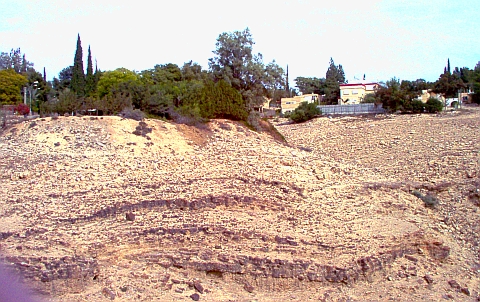Evidence of The Flood – The Land of Israel bears witness to a Great Flood
Posted by NT Wrong on December 7, 2008
Dr Rochelle Altman recently emailed me some very interesting photographs from Wadi Tavya, which is at the intersection of the Southern Judean Hills and the Negev Highlands. These photographs provide geological evidence of a widespread flood in the region, from approximately 6,500+ years ago.
The main geological evidence consists of terraces which have been cut into the banks of the Wadi. The head of the Tavya is 690 meters above sea level. Rochelle explains the significance of such terraces:
“Water erosion on the sides of mountains appears in two forms: vertical striations and circular cuts. Vertical striations are caused by rain. Circular cuts are caused by circulating water. As the water evaporates, these circular cuts leave a stepped series of what are called [“terraces”.] The Great Salt Lake in Utah is surrounded by these [terraces, there referred to as “benches”], which have been cut by the circulating water.
The exceedingly dry climate at both the Great Salt Lake and the Dead Sea preserves this ancient evidence of high flood waters.”
– Rochelle Altman
Also, the banks of the Wadi are so steep that they have not been affected by human settlement. In this photograph (“Figure 1”) the terraces are clearly visible:

Figure 1: Terraces on the north side of Wadi
“Figure 1 is part of the North side of the Wadi. In this photo we can see five different levels of arced benches cut into the side of the wadi wall by circulating water. In what bears a resemblance to raised eyebrows above the first level of benches, we can see where waves, probably caused by a violent storm, surged from side to side of the wadi. This “eyebrow” area above the series of benches and below the houses has never been “improved” by mankind. For one thing, the mountain side is far too steep. To climb over this portion of the hillside would require climbing equipment.”
– Rochelle Altman
There is also a debris layer above the terraces at Wadi Tavya, dated to ca. 6,500 years ago, which provides further evidence of this ancient shore-line. Rochelle Altman suspects that the head of the Wadi Tavya may have been a hanging lake before ca. 6,500 years ago, which became flooded and then ‘burst its banks’ before carving out a path down the Wadi. The terraces cease some 3-4 kms further down the Wadi, indicating what would be the end of the one-time hanging lake of ca. 6,500 years ago.
The flooding was a devastating event that Rochelle Altman believes “would have been carried down the centuries by the ‘memory men’ of each peoples.” The impact of the destruction resulted in stories such as the Sumerian flood story, Mesopotamian Gilgamesh, the biblical story of Noah’s Ark, and the Greek Deucalion – written between 5,000 and 2,000 years ago. And these are just the ones which have survived.
That the terraces were caused by flood waters is shown by the fact that the terraces are at the same levels on both sides of the Wadi. See Figure 2:

Figure 2: Terraces on both sides of Wadi
The terraces plausibly provide some of the present-day remains of one of the material factors involved in the production of the memory of flood stories, in the ancient Near East and Judea. An ancient age of flooding, some 6,500 to 10,000 years ago made such an impact on people that they told stories about it for thousands of years. And we still have the remains of recorded stories dating from 2,000 to 5,000 years ago. Thus, the ‘memory’ of the biblical flood story evolved from a combination of natural phenomenon (flooding during the first pluvial age) and oral/literary narrativity (the stories of the “memory men”).
Sorry, the comment form is closed at this time.
